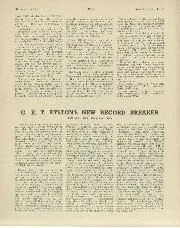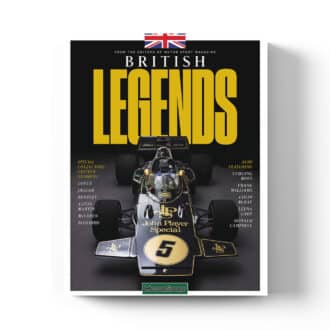
G. E. T. EYSTON'S NEW RECORD BREAKER
G. E. T. EYSTON'S NEW RECORD BREAKER 4,800 M.P. FOR 350 M.P.H. BID Great Britain has produced yet another car with which to attack world's flying start short distance records,…
NB.—Opinions expressed are those of our correspondents and Motor Sport does not necessarily associate itself with them—Ed.
THE SPEED OF BENTLEYS
Sir,
Your correspondents are waxing enthusiastic over the performance of the excellent cars manufactured by Bentley Motors (1931), Ltd., and 100 m.p.h. is claimed for both pre- and post-war models.
The following figures, taken from the Motor and Autocar road tests, may possibly be rather more factual.
In 1934 the Autocar tested the first 3 1/2-litre at 91.84 m.p.h., and subsequently obtained 88.02 m.p.h.. from a 4 1/2-litre. The Motor tested 4 1/2-litres in 1937 and 1939, obtanting 92.8 and 88 m.p.h., respectively. The post-war Mark VI when tested in 1947 had a maximum of 94 m.p.h.
I am, Yours, etc.,
London, S.W.1. CECIL CLUTTON
Sir,
With reference to the interesting lettres in your May issue about the Mark VI Bentley, your correspondents seem unaware that this car has been detuned and softened considerably since it originally appeared.
I have a 1947 model and also a 1951 edition—both standard steel saloons—and the difference in performance and handling is considerable. The early cars were much lighter, had a high-lift camshaft, lighter pistons and a thinner cylinder head gasket. With my 1947 model I have attained speedometer readings of over 100 m.p.h. on several occasions—once, in a built-up area! Perhaps this is the greatest compliment that I can pay to the superb braking system.
The 1951 car is very different and I think you will find the true reason for the change is that evil of modern life-purchase tax. This has turned the attention of many would-be buyers of a Rolls-Boyce from this coveted carriage to the modest Bentley; this gives them much the same for far less money.
Having acquired a Mark VI, they then voice their opinions of this car, and as there are lots of them the machine has’ been altered to suit their tastes.
I am constantly pressing the manufacturers for a higher performance edition of the Bentley, but so far nothing has happened.
I am, Yours, etc,.
Didcot. MICHAEL COLLIER
AN ECONOMY CAR
Sir,
After taking agood look at the present day lower priced cars which the manufacturers are turning out, the export market, the waiting list at home and the length of a car’s life after it has been bought, I consider that something ought to be done, and quickly. There is room in this island at present or a small economical car which can be produced at a low price and sold for not much more. It might even be sold in “make it yourself sets” to evade Purchase Tax, if that is not a little too far-fetched.
This car, if the Government approved, would not be exported but would, apart from cars costing over £750 (plus P.T.). be the only car available on the home market. After a while there would be no trouble at all about. spares as there would be a monopoly of these cars.
There is no doubt that these cars wotild sell, as, apart from the fact that people today buy anything in the way of cars, they would offer comfortable, economical travel, with quite good performance.
It is, of course, understood that there would be little or no chromium plating and other such things that don’t last on modern cars. The layout. would be something like this :-
Chassis.—Of simple, welded steel tube design, power unit in the rear. Suspension by semi-elliptical transverse spring at the front. (the Cooper is.a.good example of this today) and two independent 1/4-elliptical springs at the rear. Hydraulic brakes on all wheels, plus cable-operated on the back wheels. Petrol tank and spare wheel in the front. Turning circle of about thirty feet.
Power unit.-Motor-cycle twin or four-cylinder engine of 500, 650 or 1,000 c.c. A compact, yet accessible, unit with four-speed gearbox, starter and differential as one piece. Drive is by a de Dion rear axle.
Cooling will be important, as the forward speed will not be as great as a motor-cycle at the same revs. If a large enough duct is provided under the car, and at the sides if required, a fan turning at the same speed as the crankshaft, will keep the engine at a working temperature at all times.
A water-cooled unit may be designed, but as this would involve retooling and another lot of spares to stock, it is unlikely that the water-cooled engine would have any real advantage over the engines which have proved so successful in Formula III races.
Body.-Three separate. but simple, bodies could easily be made which would suits everybody’s requirements. A drophead and saloon, both with two seats, and a four-seater saloon. All would use the same chassis with a change of engine for the four-seater.
The lines of the body should be pleasing to the eye, yet simple to construct. At the front, would be a small dummy radiator, not of the frozen waterfall type. Two wings, to keep the mud off the body, and not to house such things as lights, traffic indicators or horn. Two powerful headlights, with the sidelights included, would he mounted on the tops of the wings, “FIAT-like.” By lifting the bonnet, it would be possible to get at the spare wheel, petrol tank, hydraulic brake, reserve tank and the front shock-absorbers. There would also be room enough for at certain amount of luggage to be carried. At the back would be a large lid for the engine, two rear lights and a well-lit number plate.
If the above ideas were put into practice it should result in a car, without, sloppy suspension, capable of 65-70 m.p.h. and 50-68 m.p.g. according to the model.
On the Continent there is the FIAT 500, the Renault 760 and the Volkswagen. Surely, then, we can produce something on the lines of the Austin Seven again? There would be no need at all for radios, heaters, cigarette lighters, independent front suspension or the blown-up appearance such as is the present trend, and there can be no doubt at all that models along the lines described would meet with a great demand in the home market.
Well, how about it, manufacturers?
I am, Yours. etc.,
Truro. P. M. HOSKEN.
[We should add that our correspondent is 16 years of age, so here is Youth’s advice to our manufacturers.—ED.]



